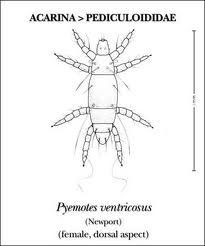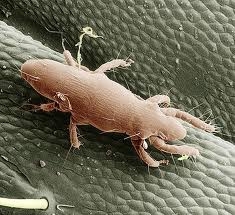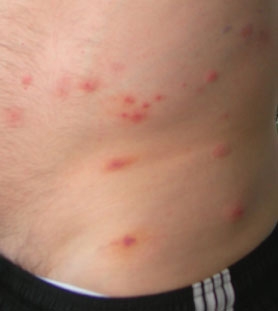The straw itch mite (Pyemotes ventricosus) is a predator living in oat hay fields. It is an extremely small mite (1/125 inch long), elongate, and whitish to translucent in color. It feeds on small insects and mites in the field and also continues to feed on these organisms in hay bales. This sounds very positive and beneficial, but this mite can also be a severe pest. During the “heat of the summer” every year, there are reports of bites and dermatitis associated with handling given lots of oat hay. The straw itch mite will move out of hay bales and readily bite humans and other animals. At the time of the bite, a prickling sensation may be felt with the “full force” of the bite being felt several hours later. Other commodities such as grains, beans, cottonseed, etc. have also been reported to be sources of this mite. Alfalfa has not been reported to be a host, but alfalfa bales can be infested if stored next to infested stacks of other hay, such as oat hay.
This pest occurs every year to some extent with reports suggesting it is worst during years following wet winters/springs. Based on reports over the years, hay originating from the coastal range/foothills seems to be most affected but the full distribution of this mite has not been studied. Populations decline slowly in stored hay and generally reach a tolerable level after winter storage. Several treatments for straw itch mite were studied in the 1980’s such as tarping hay stacks, treating the hay with an insecticide, etc. but nothing significantly reduced the mite levels. If infested hay must be fed, handling during cool periods (below ~65°F) can be helpful as the mites are less active. However, this may not offer any protection of horses, cattle, and other mammals that may be bitten. For personal protection, mosquito repellents help to keep the mites from biting and even baby oil can provide some protection.
Human response to straw itch mites varies considerably. Some people are not bothered by the mites, while others respond with large, red, itchy welts. Some people exhibit flu-like symptoms from the bites with low-grade fevers.
Line drawing of straw itch mite (www.eol.org).
Electron microscope image of straw itch mite (http://www.fibrotar.it)
Straw itch mite bites on stomach (http://freeforumzone.leonardo.it/lofi/Pyemotes-ventricosus-) .


